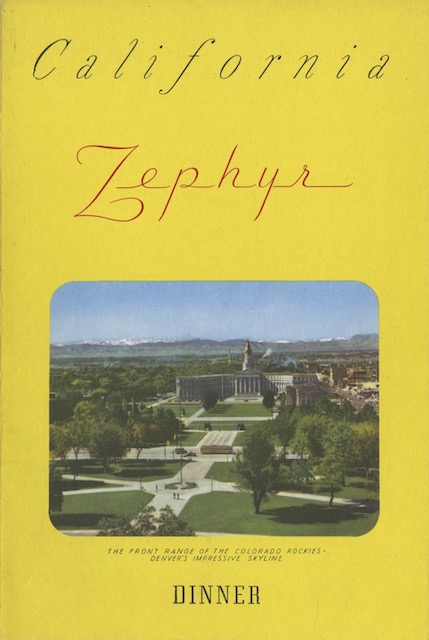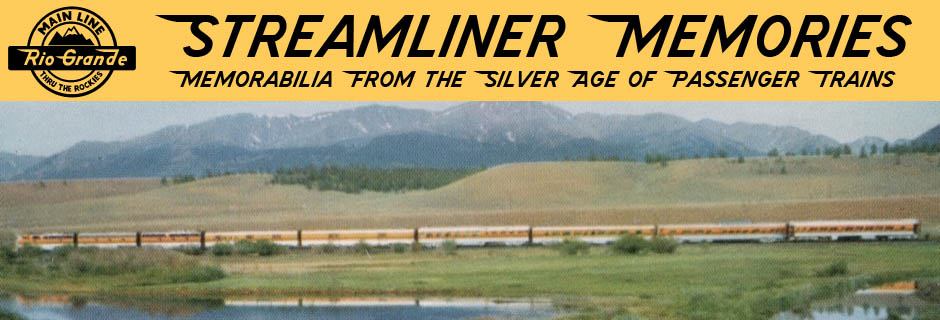The speed wars that reduced New York-Chicago and Chicago-Denver train times to 16 hours and Chicago-West Coast train times to under 40 hours were driven by the desire of business travelers to minimize the number of business hours lost in travel. A 16-hour train ride could be done during non-business hours and a 40-hour ride could be timed to require the loss of just one business day.
 Click image to download an 832-KB PDF of this menu.
Click image to download an 832-KB PDF of this menu.
After World War II, however, business travelers were increasingly attracted to the airlines. That left the railroads with vacation travelers who were more interested in enjoyable travel than in saving a few hours. The success of the Exposition Flyer proved that timing train schedules to maximize scenic viewing could be more important than sheer speed.
The introduction of the California Zephyr marked the end of the speed wars. The sub-40-hour City of San Francisco had become a daily train in 1947 and the name “zephyr” had become identified with high-speed trains such as the Twin Zephyrs and Denver Zephyr. Yet the operators of the California Zephyr made no attempt to compete on time.
Instead, they scheduled their train to take 51-1/3 hours to get from Chicago to San Francisco (and 50-1/2 hours back). They also made the train as entertaining as possible, primarily by providing five dome cars to see the scenery, a feature the City of San Francisco couldn’t easily match due to low clearances in Sierra Nevada tunnels.
At the same time that Burlington, Rio Grande, and Western Pacific officials were planning the California Zephyr, the Interstate Commerce Commission was planning to regulate the ability of railroads to offer high-speed train service. In 1947, the ICC proposed to limit passenger train speeds to 79 miles per hour on any route that did not have expensive automatic train control systems installed. Since such systems were only necessary for passenger trains, and such trains were rapidly losing customers, the railroads had little interest in spending money on automatic train controls.
(Four decades later, railway engineer/economist Steve Ditmeyer realized that automatic train control systems could actually save railroads money if they replaced, rather than merely supplemented, existing signaling systems. But the technologies Ditmeyer proposed weren’t yet available in 1947 and even today no railroad has fully implemented Ditmeyer’s ideas.)
California Zephyr planners were probably not influenced by the ICC proposals, but other railroads were. Southern Pacific, for example, withdrew from the Golden Rocket proposal because it didn’t want to install the equipment needed to run Chicago-Los Angeles trains in under 40 hours.
The California Zephyr, then, changed the speed wars into scenery wars. The photo caption of above menu, which is dated April 1949 or just days after the train began operating, emphasizes the “Front Range of the Colorado Rockies, Denver’s impressive skyline.” First-night out passengers heading west could look forward to seeing that skyline up close the next morning.
The menu is also more budget-minded than the businessman-oriented menus of some of the faster trains. Some Union Pacific menus from around 1949 offered a la carte sirloin steaks for $2.75 ($35 in today’s money) and full dinners for $2.75 to $4.25 ($53 today), prices aimed at travelers on an expense account. Meanwhile, full dinners on the California Zephyr ranged from $1.35 to $2.25 ($17 to $28 today), prices better suited to families on vacation.
In the long run, vacationing families weren’t enough to sustain the passenger train business. But in the late 1940s and 1950s, attracting such families proved to be a better formula for success than speed, especially if the latter required installation of expensive equipment.

Even superb scenery could not save the Zephyr, nor the other intercity passenger trains, a notable exception being the Coast Daylight. which had the distinction of being the only train SP never sought to remove. I’ve ridden the Coast and Shasta routes many times, and scenery never gets old.